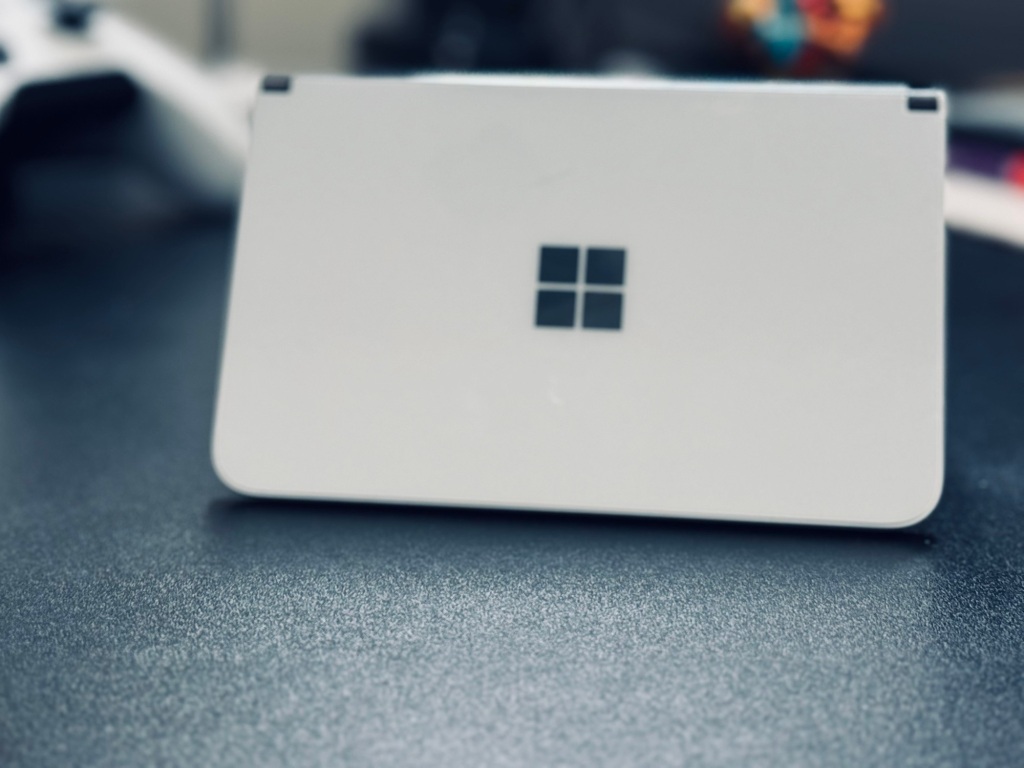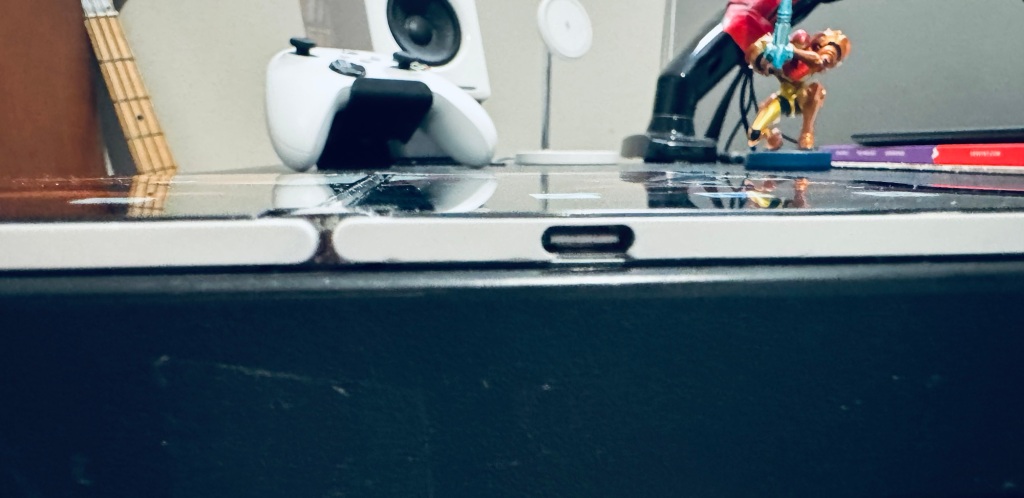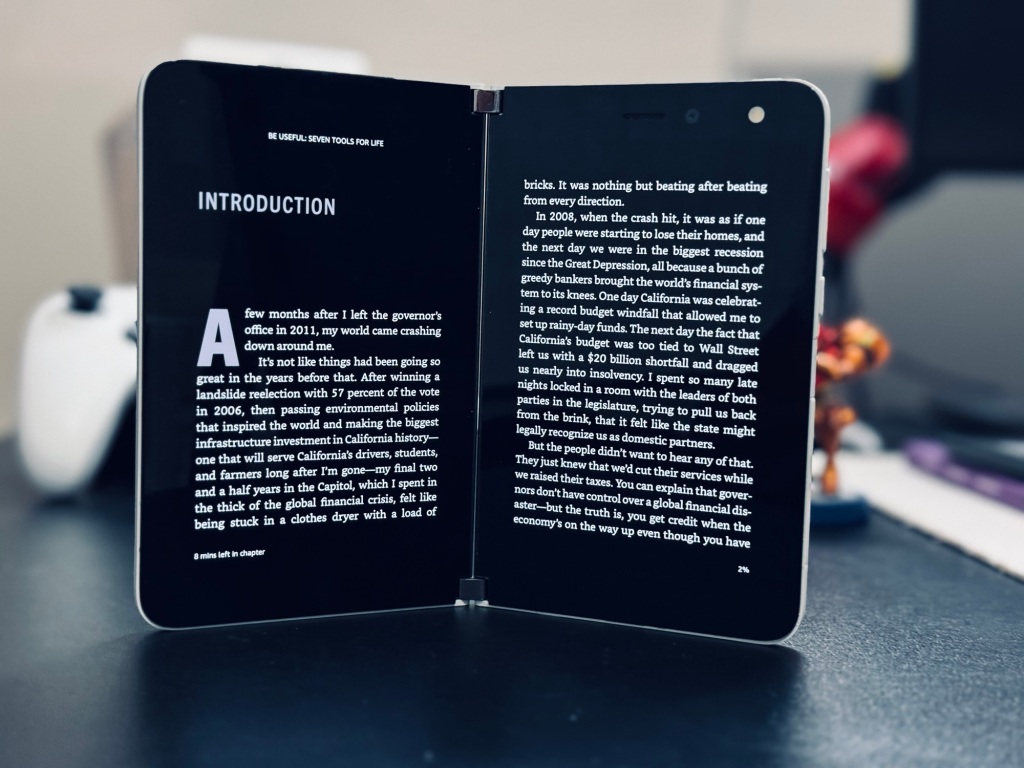
It wasn’t very popular or well liked when it was released. A second revision did nothing to help its fortunes, and rumors suggest Microsoft has put the product on ice for now. But I love the Surface Duo. And though it was never my main phone, it was a great secondary phone, and an even better work phone. Especially if your employer uses Microsoft 365.
The Duo never got Android OS updates beyond Android 12L. That means that, according to my company’s support policy, I can no longer use it to access company resources/use it as work phone. To be clear, I don’t think this is at all a bad thing. As part of a healthy data security strategy, requiring mobile devices to be on a relatively up to date operating system version is key. But it removes my last real use for the Duo, which is sad. It was one the best mobile devices I’ve used, and a promising look towards a dual screen future that never arrived.
Positives
Surface Duo has some great features. The biggest one, for me, was the lack of an outer display. Foldable phones generally have an outer screen for displaying notifications and performing quick actions. I understand that most people won’t want to unfold the device for every notification that comes in. But it bugs the crap out of me that someone could spend $1700 on a device and never unfold that inner screen. The outer screens have gotten that large. But again. I get it. This is a me problem. Surface Duo was a device I enjoyed always unfolding as it had some of the best displays I’ve experienced on a phone.
Having two distinct displays avoided problem of a crease down the center of the display. The hinge does present its own tradeoffs for watching video, but as this was primarily a work device for me, this wasn’t a huge concern. The dual displays were a huge productivity advantage. Being able to open Edge on one screen and Microsoft Teams on another without losing context was really nice. Microsoft talked a lot about the productivity benefits of dual screens in the laptop/desktop world, and how those benefits could also be applied to mobile as well. I reeeeeallllyyy think Microsoft was on to something here, but unfortunately, the market did not agree (especially at the price point Microsoft was charging).
An actual innovation that was somewhat controversial was the single inner camera that folded around to be the outward facing camera. Due to the device’s extreme thinness, this meant Microsoft couldn’t fit in the best camera. It was at best adequate. But it was a really cool idea that unfortunately went unappreciated due to camera quality. Again, this was a work phone for me, so camera quality was not high on my priority list. But I could understand how this could be a huge problem if this was your primary device.
Did I mention this device is gorgeous? Unfolded, it was only 4.8 mm thick, which is insane. I’m still on a white/silver electronics kick, so the Glacier finish really caught my eye. And when was the last time you came across a phone without a camera bump?
Drawbacks
The initial reviews rightly criticized the Duo in two key, probably related, areas….performance and touch response. The SoC the original Surface Duo used was the Snapdragon 855, which was out of date when the product launched. The device also “only” had 6 GB of ram, which apparently doesn’t go as far in the Android world as it does on iOS.
As the story goes, the Duo hardware was originally planned to ship with a version of Windows, but management eventually decided to go with Android. With their Windows Phone platform, Microsoft had already been burned by not having the most popular mobile apps on their platform. Embracing Android was seen a way to solve that problem. However, this made Microsoft beholden to Google for the direction of the software on its flagship device. And as the relationship soured, this put Microsoft behind its competitors in getting access to new Android versions.
Depending on who h two apps I was using, you could definitely feel the device bogging down. Never to the point of being unusable, but certainly to the point of being annoying. But this wasn’t nearly as annoying as the poor touch response issues. It often takes multiple taps or swipes to bring up the app launcher or launch an app. I don’t know if the issue was software, hardware, or both, but if Microsoft could have solved these issues, it would have gone a long way to the Duo receiving a much more positive reception. I don’t believe these issues were addressed with the Surface Duo 2, but I never got my hands on one because
- I don’t recall seeing the same kind of fire sale that allowed me to afford a Duo 1
- I hated the way the new camera ruined the form factor. It was better for taking pictures, but made it so the device would no longer be flat when you folded it around 😡.
This is the part where you’d expect me to complain about the bezels, which were sizable even for 2020 standards. But oddly enough, I’ve never been too bothered. I find I’m focused more on the screen itself.
The plastic around the usb port breaking was more obnoxious.

I’ve never used a Galaxy Fold or a Pixel Fold for more than a few minutes, so I don’t know what the improvements for foldables Google has been making in Android 13 and 14. Maybe they’ve affected the number of optimized applications that are available. I won’t get to know, because, again, Microsoft never pushed an OS update beyond Android 12L. There were a scant few apps that even took advantage of the Duo’s form factor. The only non Microsoft app I can think of would be Kindle, and I imagine some money exchanged hands to make that happen.

Conclusion
The Surface Duo wasn’t the first dual screen phone, but it was the first one that seemed like it had a real vision behind it. There’s a saying that Microsoft usually gets something right by the third version, but it looks like we’ll never know if that was true in the case of the Duo. Which is a real shame. This has been of my favorite Android devices, right up there with the original HTC One.
At this point, I plan on resetting my Duo and trying to use it as something of a personal Android tablet, to the extent I can. I’ll always feel a little sad about it, since it never really got to live up the potential of this form factor.

![iPadOS 18 FINALLY Adds the Ability To Format External Storage [VIDEO]](https://slatepad.org/wp-content/uploads/2024/06/untitled.png?w=1024)



Leave a comment